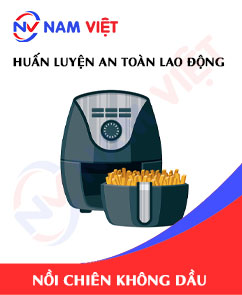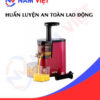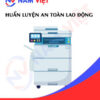Occupational Safety Training in Air Fryer Manufacturing
99,000 ₫
Note: The above price is calculated for one person, the price may fluctuate depending on the number of trainees participating in the course and depending on market movements. For more accurate pricing support, please refer to the quotation table or contact our consulting staff directly.
Occupational safety is an important issue in air fryer manufacturing factories and needs to be addressed promptly to ensure the health and safety of workers, and to enhance the reputation of businesses. The Occupational safety training course is one of the effective solutions to raise awareness about accident prevention for workers participating in air fryer manufacturing.
Table of Contents
Toggle1. Overview of Air Fryers
a. What is an Air Fryer?
An air fryer, also known as an Air Fryer, is a type of household appliance designed to cook food quickly and conveniently without the need for oil as in traditional methods. An air fryer operates by using hot air and a rotating mechanism to cook food. This device is designed with a removable cooking tray that is easy to clean after use.
Air fryers can be used to cook a wide variety of foods, including French fries, fried chicken, fish, shrimp, vegetables, bread, pastries, and many other foods. Some air fryers allow temperature and cooking time adjustments to ensure food is evenly cooked and appetizing. An air fryer can be an excellent choice for those who want to eat healthily while still enjoying their favorite crispy fried foods.

b. Types of Machinery for Air Fryer Manufacturing
To manufacture and assemble air fryers, companies typically use various machines to carry out manufacturing and assembly processes. Some of the machines used in air fryer manufacturing and assembly include:
- Metal cutting machines: These machines are used to cut metal parts of the air fryer, including the outer casing, trays, and other components.
- Metal pressing machines: These machines are used to press metal parts of the air fryer, including the outer casing and other components.
- Metal welding machines: These machines are used to weld the metal components of the air fryer together.
- Plastic molding machines: These machines are used to mold plastic components of the air fryer, including protective parts and cooking trays.
- Die stamping machines: These machines are used to create molds for molding plastic parts of the air fryer.
- CNC machining machines: These machines are used to machine metal components of the air fryer, including grinding, drilling, and precision machining.
- Testing machines: These machines are used to check the quality of the air fryer before shipment, including testing voltage, pressure, functionality, and product durability.
These machines are used in the manufacturing and assembly of air fryers to ensure product quality while saving time and manufacturing costs.

c. Air Fryer Manufacturers in Vietnam
Currently, there are many brands producing air fryers with different features and functions, depending on users’ needs and budgets. Some well-known air fryer brands include:
- Philips: A well-known brand in air fryer manufacturing, offering high-quality products with smart features.
- Tefal: A French brand producing a wide range of air fryers with diverse features, from multifunctional cooking to aesthetic and easy-to-use designs.
- Ninja: A brand producing air fryers and other cooking appliances, known for stylish designs and versatile functions.
- Cosori: A US brand producing air fryers with smart features, including temperature control and cooking program storage.
- GoWISE USA: An affordable air fryer brand offering a variety of features and functions.
- Cuisinart: A brand producing premium kitchen appliances, including air fryers, with attractive design and smart features.
- Instant Pot: A Canadian brand producing multifunctional cooking appliances, including air fryers, with diverse and user-friendly functions.
These brands are popular and trusted options when purchasing an air fryer. Consumers should also consider factors such as price, features, durability, and user reviews before making a purchase decision.

d. Specific Jobs in an Air Fryer Manufacturing Factory
Group 1
- CEO, Deputy CEO, and department heads in the air fryer manufacturing factory.
Group 2
- Safety officers: Manage safety in the factory, design safety procedures, supervise and enforce employee compliance with safe working practices.
Group 3
- Component fabrication: Components such as the fryer body, trays, and filters are manufactured in the factory from materials such as plastic, stainless steel, aluminum, copper, etc.
- Product assembly: After producing the necessary components, assembly staff assemble the products by fitting components together and testing product functionality.
- Quality control: After assembly, the manufacturer performs quality checks to ensure the air fryer works properly and meets the required quality standards.
- Packaging: Products are packaged and prepared for shipping and storage.
- Transportation: Products are transported to retailers or distributors for delivery to end customers.
Group 4
- Office work, service, sales, and marketing.
- Manufacturing management, quality management, human resource management, material management, financial and accounting management.
- Product design and research: This involves studying market and customer needs, generating design ideas, and researching features, technology, shape, size, color, materials, etc., to produce new air fryer models.

2. Overview of Occupational Safety Training for Air Fryer Manufacturing
In this article, we focus on issues related to Group 3 because Group 3 directly participates in the manufacturing process and faces the highest occupational safety risks. For more information about other groups, see here.
a. What is Group 3 Occupational Safety Training?
- Group 3 occupational safety training consists of courses that provide workers with awareness of how to prevent occupational accidents.
- This training helps workers recognize and avoid hazards, minimizing the risks of workplace accidents.
REGISTER FOR OCCUPATIONAL SAFETY TRAINING SERVICE
b. Training Duration
Initial occupational safety training
- Total training time is at least 24 hours, including testing time.
- 8 hours of theory on occupational safety policies and laws
- 8 hours of theory on basic occupational safety knowledge
- 4 hours of theory on specialized training content
- 2 hours of practical training on specialized content
- 2 hours of theoretical testing at the end of the course
The training center schedules multiple sessions depending on employee availability. Typically, there are six sessions over three days, assuming the company can arrange consecutive training time.
Periodic occupational safety training
- Before the occupational safety card expires, workers who want to renew it must complete periodic occupational safety training with a duration of at least 50% of the initial training time.
Explanation: The total duration of periodic occupational safety training is at least 12 hours, including testing. After completing the course and passing the test, workers are reissued or extended their occupational safety card.
c. Training Content
| No. | TRAINING CONTENT | TRAINING DURATION (HOURS) | |||
| Total | Including | ||||
| Theory | Practice | Test | |||
| I | Occupational safety policies and laws | 8 | 8 | 0 | 0 |
| 1 | Overview of legal documents on occupational safety and hygiene. | 6 | 6 | ||
| 2 | Standards and technical regulations on occupational safety and hygiene. | 1 | 1 | ||
| 3 | Specific regulations of state management agencies regarding occupational safety when constructing, expanding, or renovating facilities and managing machines, equipment, materials, and substances with strict safety and hygiene requirements. | 1 | 1 | ||
| II | Basic occupational safety knowledge | 8 | 8 | 0 | 0 |
| 1 | Basic knowledge of workplace hazards and risks. | 4 | 4 | ||
| 2 | Methods to improve working conditions. | 1 | 1 | ||
| 3 | Safety culture in manufacturing and business. | 1 | 1 | ||
| 4 | Rights and responsibilities of employers and employees; occupational safety policies for employees; functions and duties of safety officers. | 1 | 1 | ||
| 5 | Safety rules, signage, instructions, use of safety equipment, personal protective equipment; first aid skills and occupational disease prevention. | 1 | 1 | ||
| III | Specialized training content | 6 | 4 | 2 | 0 |
| Comprehensive knowledge of machines, equipment, substances causing hazards; analysis, risk assessment, occupational safety management, safe work procedures with machines, equipment, and substances with strict safety requirements. | 6 | 4 | 2 | ||
| IV | Final occupational safety test | 2 | 2 | 0 | 0 |
| Total | 24 | 22 | 2 | ||
See more training content of all six groups
d. Occupational Safety Card
After completing the occupational safety training and passing the test, workers will be issued an Occupational Safety Card (commonly known as Group 3 Safety Certificate).
The Group 3 safety card clearly displays information such as full name, date of birth, specific job, and working environment. It also includes training duration, a red stamp, and signature confirming completion of the training course.
According to the regulations specified in Clause 2 of Article 24 of Decree 44/2016/ND-CP, there are two cases:
- If the employer and employee have a labor contract, the employer must sign and stamp the safety card for the trained Group 3 employee after the training from a certified occupational safety training unit and passing the test.
- If the worker is freelance or seasonal and does not have a labor contract, the training unit must sign and stamp the safety card after completing the occupational safety training and passing the test.

3. Recognizing Hazards Affecting Workers in Air Fryer Manufacturing
During the manufacturing of air fryers, there are several hazards that may affect the health and safety of workers. Below are some common hazards in air fryer manufacturing:
- Risk of impact or slipping: When working in an air fryer manufacturing factory, workers may experience impacts or slips if they are not careful or do not follow safety rules.
- Risk of electric shock: When working with electrical equipment in an air fryer manufacturing factory, workers may experience electric shock if safety rules are not followed.
- Risk of fire or explosion: During air fryer manufacturing, flammable materials or cutting/grinding tools may cause fire or explosion hazards.
- Risk of chemical exposure: Chemicals such as solvents, paints, adhesives, etc., used in air fryer manufacturing may pose exposure risks and harm workers’ health.
- Risk of tripping on equipment and machinery: Equipment and machinery used in air fryer manufacturing may cause tripping hazards and injuries for workers.

4. Common Occupational Accidents in Air Fryer Manufacturing
Common occupational accidents in air fryer manufacturing include:
- Accidents cutting fingers or hands: Air fryer manufacturing equipment may have sharp edges or cutting blades. Failure to follow safety rules while using these tools may result in finger or hand injuries.
- Impact accidents: Equipment and machinery in air fryer manufacturing may cause impact injuries if safety rules are not followed.
- Fire or explosion accidents: Flammable materials or cutting/grinding tools used during air fryer manufacturing may cause fire or explosion accidents.
- Electrical accidents: When working with electrical equipment in air fryer manufacturing, workers may experience electric shocks if safety rules are not followed.
- Chemical accidents: Chemicals such as solvents, paints, adhesives, etc., used in air fryer manufacturing may lead to exposure accidents and harm workers’ health.
- Machinery-related accidents: Equipment and machinery in air fryer manufacturing may cause tripping, entrapment, or other injuries if safety rules are not followed.

5. Safety Measures When Participating in Air Fryer Manufacturing
Safety measures to be applied when participating in air fryer manufacturing include:
- Occupational Safety Training for Workers: Workers should be trained on potential hazards during manufacturing, proper use of protective equipment, and safe procedures to minimize occupational accidents.
- Use of protective equipment: Protective equipment such as safety glasses, face shields, gloves, ear protection, safety shoes, etc., should be used to reduce potential hazards during air fryer manufacturing.
- Inspection and maintenance of equipment: Equipment and machinery in the air fryer factory must be regularly inspected and maintained to ensure safety for workers and products.
- Use of safe materials: Safe materials and correct procedures should be followed during manufacturing to avoid flammable or harmful substances.
- Implement quality control: Products should be checked for safety and quality standards before being released to the market.
- Ensure factory hygiene: Protect workers’ health by maintaining hygiene in the factory and using safe chemicals and proper sanitation procedures.
- Follow safety procedures: Workers should strictly follow safety procedures during work to avoid dangerous actions that could lead to accidents.
- Periodically conduct workplace environmental monitoring in the factory, collecting and analyzing harmful factors to adjust and reduce hazards, preventing occupational diseases for workers.
6. Benefits of Occupational Safety Training in Air Fryer Manufacturing
An Toan Nam Viet provides businesses with the following benefits upon completing occupational safety training courses in accordance with Decree 44/2016/ND – CP on Occupational Safety and Hygiene:
- Workers can recognize potential occupational hazards and take preventive measures to avoid accidents.
- Businesses can establish risk prevention measures in manufacturing, operation, and maintenance processes.
- Reduce costs associated with safety risks at work.
- Continuous manufacturing improves labor productivity and product quality.
- Compliance with occupational safety laws to avoid legal risks.
- Enhances reputation and professionalism, elevating the business brand.
An Toan Nam Viet training courses are solutions to prevent external hazards, helping individuals avoid injuries or more serious consequences, including death.
REGISTER FOR OCCUPATIONAL SAFETY TRAINING SERVICE
7. Customer Feedback After Completing Occupational Safety Training in Air Fryer Manufacturing
An Toan Nam Viet has many years of experience accompanying numerous businesses across Vietnam, especially in the southern provinces. This responsibility is invaluable to us, which is why our Occupational Safety Training is continuously becoming more professional. The motivation behind An Toan Nam Viet’s growth comes from positive feedback and suggestions from our partners. Below are some testimonials from our clients:
Bac Nam E&C Investment and Construction Joint Stock Company
“My first experience with An Toan Nam Viet was impressive due to the 24/7 support from the consulting team. The class organization was fast and convenient for our company. Thank you very much for Nam Viet’s service!”
Hoa Dat Construction and Trading Joint Stock Company
“Nam Viet’s service greatly helped us simplify occupational safety and complete safety documentation for our work process. The consulting team responded promptly to our inquiries. Five stars for Nam Viet.”
See more customer interviews after using services from An Toan Nam Viet
8. Occupational Safety Training Capacity of An Toan Nam Viet
An Toan Nam Viet is a reputable and quality center for occupational safety training in Vietnam. Our training sessions are continuously held at factories, workshops, or construction sites across the country (all 63 provinces in Vietnam).
REGISTER FOR OCCUPATIONAL SAFETY TRAINING SERVICE
Occupational safety training license
- An Toan Nam Viet has been inspected and certified by the Department of Safety under the Ministry of Labor – Invalids and Social Affairs and granted a certificate of eligibility for occupational safety and hygiene training. This further reinforces our training capacity.

Training materials and lectures
- Before being applied to occupational safety training courses, all materials are reviewed to ensure knowledge accuracy and effective application.
- The teaching methods of instructors follow An Toan Nam Viet standards, developed by experts in occupational safety and hygiene training to maximize knowledge retention for trainees.
Facilities
- Controlling classroom factors affecting training increases teaching efficiency and knowledge absorption for trainees.
- Our training support facilities provide spacious classrooms meeting standards for area, lighting, and training equipment.
9. Nationwide Reputable and Quality Safety Training Center
At An Toan Nam Viet, we prioritize professional dedication in occupational safety training. For us, imparting knowledge on self-protection to workers equips them with safety tools for their livelihood and contributes to nation-building.
To ensure effective training, we meticulously prepare all tools, teaching equipment, curricula, materials, sound, and lighting.
Our instructors are experts with years of experience in the field, including research projects on hazard identification across industries and prevention methods.
Lectures are based on practical experience and delivered in a lively, easy-to-understand manner for workers. Knowledge is always aligned with Decree 44/2016/ND-CP.
Workers learn hazard prevention methods and self-protection, applying them appropriately in real work situations.
Our training center proudly offers professional and reliable occupational safety training with advantages such as:
- Competitive training fees without compromising quality.
- Flexible training schedules suitable for company manufacturing.
- Fast and legal-compliant certification procedures for occupational safety training.
- Experienced and long-standing instructors.
- Classrooms controlled for factors affecting training efficiency and knowledge retention.
- Lectures tailored to occupational safety in businesses.
- An Toan Nam Viet works diligently and professionally to provide accurate and prompt customer support.

10. Additional References for Occupational Safety Training in Air Fryer Manufacturing
- Occupational Safety Training Materials Collection
- Occupational Safety Training Test Collection
- Occupational Safety Materials for Air Fryer Manufacturing
- Occupational Safety Training Curriculum for Air Fryer Manufacturing
- Occupational Safety Quiz for Air Fryer Manufacturing
1 review for Occupational Safety Training in Air Fryer Manufacturing
No comments yet















namchinh.haiphong341
Dịch vụ ở đây tốt nhé!